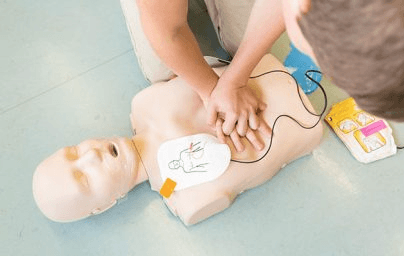
Thankfully, we see more AEDs (automated external defibrillators) for public access in places like gyms, schools, pools, casinos, and larger business offices. CPR (cardiopulmonary resuscitation) classes now provide additional education for using these small but mighty machines. That’s good news because sudden cardiac arrest can happen anywhere.
Using an AED in conjunction with timely CPR can significantly increase survival rates in individuals experiencing sudden cardiac arrest.
Using an AED is easy as the machine vocalizes each step once the power button is initiated. Whether you are familiar with AEDs and want to brush up on your knowledge or you are just AED-curious, let’s take a deeper dive into lesser-known facts about AED use.
Remember, in any emergency, call 911 first after assessing that the area of the emergency is safe. Always follow their instructions.
Do I need special training to use an AED?
While classes do help, AEDs are specialized in that they can and should be used immediately without prior knowledge. The machine gives step-by-step prompts making their use accessible for anyone to use successfully.
Can I get in trouble if I attempt to assist using an AED?
No. The federal Good Samaritan Law will protect strangers who attempt any lifesaving CPR or AED use. The extent of this law does vary state-by-state but generally covers what a reasonable bystander does.
What if I don’t know if they are having a heart attack or sudden cardiac arrest?
A heart attack is a result of a blockage in the arteries that feed the heart muscle. Sudden cardiac arrest is a malfunction of the electricity running the heartbeat. The use of an AED will NOT help a heart attack victim. The AED machine will accurately analyze the need for an electric impulse. Only use an AED when the victim is unconscious and not breathing.
Can I hurt someone with an AED?
No. An electrical shock will only be administered by the AED if the victim needs it. You cannot accidentally shock someone.
Can I use an AED on a child?
If the parent of a child over the age of 1 GIVES CONSENT for intervention, then an AED can be used legally and safely on children over 8 years old with AED adult pads. Pediatric pads are often found with AEDs for use on children under age 8 or less than about 55 pounds. If not, an adult pad may be applied to the chest and back of the child victim. If the victim is an infant, start infant CPR and do NOT use an AED.
Can AEDs be used if someone is wet?
Do NOT use an AED if someone is submerged in water or snow. It can be safely used if they are on snow or ice but NOT if their body is laying in water. In this case, move the victim to a dry surface or on a dry towel/clothing. Rip or cut their wet clothes off, dry off the chest, armpits, sides, and neck areas and place the pads in dry areas as instructed by the AED voice prompts.
What if the victim is obviously pregnant?
Call 911 and follow their instructions BEFORE using the AED.
What if the victim has a hairy chest?
AEDs often come with disposable razors for quick removal of chest hair. Hair can impede AED functionality.
What if I notice the victim has a pacemaker implanted in their chest?
Do not place AED pads directly on top of the pacemaker but as close to the ideal location as possible.
What if I notice the victim has a medication patch on their chest?
If the medication patch is in the way of the pad target area, simply remove the medication patch and quickly wipe the area.
Which is better: CPR or AED use?
As always, call 911 first then follow the instructions of 911 dispatch personnel. Starting CPR (when the victim is unconscious and not breathing) while the AED is being located and set up can double survival rates. If you are alone, start and continue CPR after calling 911. If there are others around you, ask for someone to locate and set up the AED while you continue CPR.
AEDs are set up for life-saving success. If you witness what you suspect to be sudden cardiac arrest, don’t delay! Your emergency response may just save a life.
Resources:
Centers for Disease Control and Prevention. Public Access Defibrillation State Law Fact Sheet.
Emedicinehealth. Should you do CPR or AED first?
